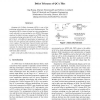Free Online Productivity Tools
i2Speak
i2Symbol
i2OCR
iTex2Img
iWeb2Print
iWeb2Shot
i2Type
iPdf2Split
iPdf2Merge
i2Bopomofo
i2Arabic
i2Style
i2Image
i2PDF
iLatex2Rtf
Sci2ools
DATE
2006
IEEE
2006
IEEE
Defect tolerance of QCA tiles
Quantum dot Cellular Automata (QCA) is one of the promising technologies for nano scale implementation. The operation of QCA systems is based on a new paradigm generally referred to as processing-by-wire (PBW). This paper analyzes the defect tolerance properties of PBW when tiles are employed using molecular QCA cells. Based on a 3 × 3 QCA block, with different input/output arrangements, different tiles are analyzed and simulated using a coherence vector engine. The functional characterization and polarization level of these tiles for undeposited cell defects are reported. It is shown that novel features of PBW are possible due to spatial redundancy and QCA tiles are robust and inherently defect tolerant. Index words: QCA, defect tolerance, emerging technologies.
| Added | 10 Jun 2010 |
| Updated | 10 Jun 2010 |
| Type | Conference |
| Year | 2006 |
| Where | DATE |
| Authors | Jing Huang, Mariam Momenzadeh, Fabrizio Lombardi |
Comments (0)

